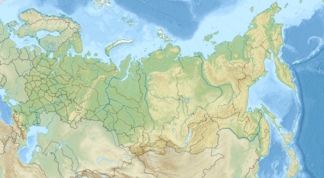Salary backs
| Salary backs | ||
|---|---|---|
| Highest peak | Kiwda ( 621 m ) | |
| location | Kemerovo Oblast , Novosibirsk Oblast , Altai Region ( Russia ) | |
|
|
||
| Coordinates | 54 ° 5 ′ N , 85 ° 50 ′ E | |
| rock | Limestone , sandstone , tuff , granite | |
The Salair ridge ( Russian Салаирский кряж Salairski krjasch , also Salair for short ) is a low mountain range in Western Siberia up to 600 m high .
The name probably comes from the Turkish - Mongolian name of the river Sairair (Сайраир), which means "small, dry, stony river", which was first transferred to the village of Salairka (today's city of Salair ) and later to the entire mountain range .
geography
The wage ridge stretches for about 300 km in an arc from southeast Novosibirsk via southwest Novokuznetsk to northeast of Biysk . The width of the plateau-like ridge is about 50 km. It rises relatively flat on the southwest flank, while the northeast flank, the Tyrganschwelle (уступ Тырган), drops steeply in many places and delimits the Kuznetsk Basin in the west. Rounded relief forms predominate, the peaks and ridges are flattened.
Usually around 400 to 500 m high, the highest elevation on the wage ridge is Mount Kiwda (Кивда) at 621 m above sea level. NN in the otherwise lower southwest part of the salary ridge.
The rivers Berd and Tschumysch , right tributaries of the Ob , have their origin in the Salair .
The wage ridge stretches along the border of Kemerovo Oblast , Novosibirsk Oblast and the Altai Region .
geology
The mountain range is formed from crystallized limestone , sandstone , tuff, and granite that were folded in the Middle and Late Cambrian and later raised. Deposits of heavy metal ores have been discovered, which are mined in the area of the city of Salair.
flora
Most of the mountains are covered by mixed ( aspen and fir ) and deciduous forests (aspen and birch ). In the area of the steeper northeast flank there are also larch and pine forests as well as steppe sections . Steppes also predominate in the lower western part of the mountains.
traffic
In the middle part of the wage ridge is crossed by the Barnaul - Novokuznetsk railway line, completed in 1952 .
Individual evidence
- ↑ Article wages back in the Great Soviet Encyclopedia (BSE) , 3rd edition 1969–1978 (Russian)

